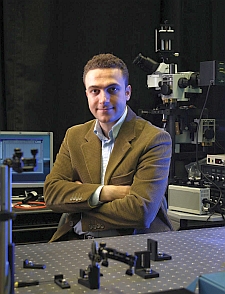30 April 2015. A bioengineering lab at University of California in Los Angeles is developing a smartphone attachment that can image and measure the length of DNA molecules. The team led by engineering professor Aydogan Ozcan is scheduled to describe the system on 14 May at the Conference on Lasers and Electro-Optics sponsored by the Optical Society and other organizations in San Jose, California.
Ozcan and colleagues are building a device to provide point-of-care diagnostics for complex disorders such as Alzheimer’s disease, antibiotic-resistant bacteria, and some types of cancer that require an analysis of individual DNA molecules. The researchers designed the system to offer the same capabilities that now use large and expensive analytical microscopes installed in laboratories, but for small clinics, often in remote locations.
The UCLA system includes a lens, thin-film optical filter that allows certain wavelengths to pass through, and laser-producing diode chip installed in a 3-D printed case that attaches to a smartphone. The system first requires DNA molecules be isolated and labeled with fluorescent tags, which makes it possible to record images of ultra-thin DNA strands, each about 2 nanometers wide.
The DNA images are first analyzed by software on the phone that combine Windows applications with custom computational algorithms, then sent to a server in the Ozcan lab for measurement. Once a reliable connection is established, say the researchers, a full analysis takes about 10 seconds. Ozcan notes similar devices built by his lab and others can record images of individual cells, but this is the first of its kind to drill down to individual DNA molecules.
Tests of the device show the system can accurately image stretched and fluorescent-tagged DNA molecules of 10,000 base pairs or larger. The researchers say DNA molecules of this size include those found in many key genes, including the gene that make staph bacteria resistant to antibiotics, which has some 14,000 base pairs. Base pairs are basic chemical building blocks of DNA whose order determines an individual’s genetic code. Human DNA contains about 3 billion bases.
Tests also show that the microscope is less accurate in measuring DNA molecules with 5,000 base pairs or less. Ozcan says the problem can be fixed using a lens with a higher numerical aperture, making it better able to gather light and resolve more detail in the image. The lab plans to test the system next in the field to detect the presence of malaria-related drug resistance.
Ozcan is credited as an inventor in 50 patents on biomedical imaging filed or granted since 2005.
Read more:
- Trial Testing App to Manage Diabetes, Foot Ulcers
- Trial Testing Mobile Apps for Mood Management
- Mobile Diabetes Device Maker Lands $20M in Venture Funds
- Mobile App in Development to Manage COPD
- Hand-Held DNA Sequencer IDs Bacteria, Viruses
* * *


 RSS - Posts
RSS - Posts
You must be logged in to post a comment.